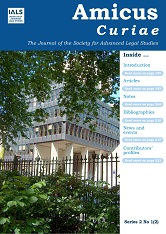Limits to Terror Speech in the UK and USA: Balancing Freedom of Expression with National Security
DOI:
https://doi.org/10.14296/ac.v1i2.5130Abstract
Article 10(1) of the European Convention on Human Rights, freedom of expression, is incorporated into UK law. With the growing Islamist terror threat after 9/11, particularly threatening European security, the Council of Europe introduced the Convention on the Prevention of Terrorism (CPT) 2005. One of the Articles within the Convention, Article 5, obliges states to outlaw ‘public provocation to commit a terrorist offence’. Drawing on its obligations in the CPT, the UK enacted section 1 of the Terrorism Act 2006: ‘encouragement of terrorism’. But, in implementing its duties, the UK went further. There are very real concerns, therefore, about the effects of this legislation on freedom of expression. The test for interpreting breaches of Article 10 is ‘proportionality’. Comparatively, in America there is a much stronger test than proportionality, ‘strict scrutiny’, in assessing limits to terror speech. However, in the age of Islamism, together with the speed, ease and little cost incurred in sharing terror speech online, should there not be a reappraisal of American law? The author is based in the UK. But the UK’s approach to limiting terror speech is arguably too intrusive of freedom of expression. This paper, therefore, proposes a compromise approach between the two jurisdictions.
Downloads
Downloads
Published
Issue
Section
License
Those who contribute items to Amicus Curiae retain author copyright in their work but are asked to grant two licences. One is a licence to the Institute of Advanced Legal Studies, School of Advanced Study, University of London, enabling us to reproduce the item in digital form, so that it can be made available for access online in the open journal system, repository, and website. The terms of the licence which you are asked to grant to the University for this purpose are as follows:
'I grant to the University of London the irrevocable, non-exclusive royalty-free right to reproduce, distribute, display, and perform this work in any format including electronic formats throughout the world for educational, research, and scientific non-profit uses during the full term of copyright including renewals and extensions'.
The other licence is for the benefit of those who wish to make use of items published online in Amicus Curiae and stored in the e-repository. For this purpose we use a Creative Commons licence (http://www.creativecommons.org.uk/); which allows others to download your works and share them with others as long as they mention you and link back to your entry in Amicus Curiae and/or SAS-SPACE; but they can't change them in any way or use them commercially.



